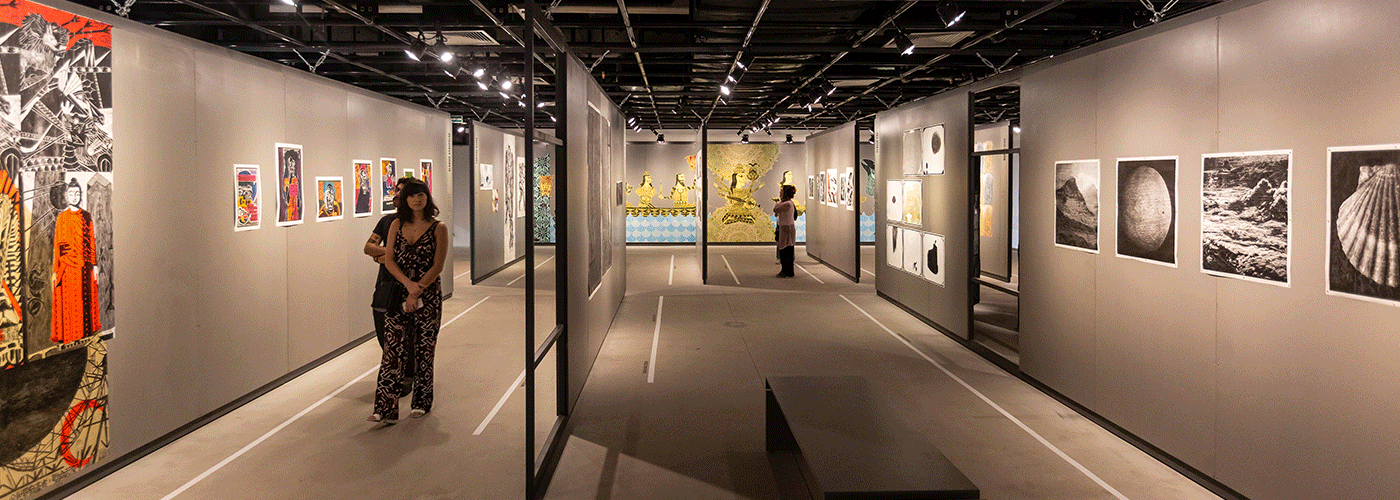May 14–September 15, 2019
Jardim Flor do Campo
R. Guilherme Lino dos Santos, nº 1.200
São Paulo-
07190-010
Brazil
This last month of May saw the inauguration of the newest venue of Sesc São Paulo and, with it, a new exhibition space. Located in the district of Jardim Flor do Campo, in the city of Guarulhos, within the Greater São Paulo metropolitan region, Sesc Guarulhos is opening its 400-square-meter exhibition space with the show Xilo: Corpo e Paisagem [Woodcut: Body and Landscape]. This entirely new initiative presents the recent production in woodcut from São Paulo, in a systematic, historically contextualized way.
Printmaking using the technique of woodcut has an extensive modern and popular tradition in Brazilian culture, and a unique history in the context of São Paulo. The show presents a critical perspective on this technical resource in local contemporary art, focused on the 1990s and onward. Curated by Claudio Mubarac (Rio Claro, SP, 1959)—a Brazilian artist, researcher and professor with the School of Communication and Arts of the Universidade de São Paulo—the exhibition springs from research and critical accompaniment of printmaking in the urban context of Brazil’s largest city. According to the curator himself, this gathering of woodcuts presents “a graphic adventure that takes place in the city.”
The curatorship’s conceptual and historical approach considers a relevant moment in the local context: the emergence and organization of independent studios and workshops, apart from any institution, where printmaking production is conceived, shared and discussed in a more spontaneous way, often on the fringe of the art spaces and taking part in the public sphere. It is a social and artistic phenomenon that has taken shape over the last decades.
With a certain public character, this production in woodcut has retained the value of artisanal work and resistance in times of the unbridled spread of digital devices, even while also making use of technological apparatuses itself. Far from the purism of printmaking in the first years of the 20th century, this production is anchored in the recent urban reality, stimulating “a diachronic and synchronic coexistence between the processes for constructing images through the use of a matrix.”
The show features more than 100 artworks by artists who have different profiles in regard to age and experience as well as their thematic and formal approach. The following artists, groups or artist collectives are participating:
Ana Calzavara, Augusto Sampaio, Beatriz Lira (Xiloceasa), Claudio Caropreso, Cleiri Cardoso, Danilo Juliano (Xiloceasa), Denis Araújo (Xiloceasa), Eduardo Ver, Ernesto Bonato, Fabrício Lopez, Fernando Melo (Xiloceasa), Fernando Vilela, Flavia Yue, Flavio Capi, Francisco Maringelli, Gabriel Balbino (Xiloceasa), Gilberto Tomé, Igor Romualdo (Xiloceasa), Luciana Bertarelli, Luciano Ogura, Luisa Almeida, Luiz Lira (Xiloceasa), Marcio Elias, Mateus Costa (Xiloceasa), Otávio Zani, Paulo Penna, Pedro Pessoa, Ramon Santos (Xiloceasa), Revista Comando, Santídio Pereira, Simone Pereira, Taís Melo (Xiloceasa) and Ulysses Bôscolo.
The exhibition also includes educational activities, integrated with the show’s context and conceived together with the participating artists during the course of its production. There are guided visits, lectures, workshops and courses scheduled for these first months of Sesc Guarulhos’s operations. Designed by the Dal Pian Arquitetos Associados architectural firm, the 34.2-thousand-square-meter constructed space of this cultural sports and leisure center includes ample settings for the public to make contact with art and engage in dialogue about it, including in areas outside of its exhibition spaces strictly speaking.
These new facilities will also provide the general public with access to the artworks in Sesc São Paulo’s permanent collection. In its spaces and public leisure areas, visitors to this new Sesc can see works by renowned Brazilian artists such as Adriana Varejão, Anna Bella Geiger, Carlito Carvalhosa, Claudia Andujar, Eduardo Frota, Janaina Tschäpe, Leonilson, Sérvulo Esmeraldo, Sidney Amaral, and others. In this sense, the Greater São Paulo metropolitan region has gained a new place dedicated to the visual arts, promoting and disseminating Brazilian art to both local and foreign audiences.



